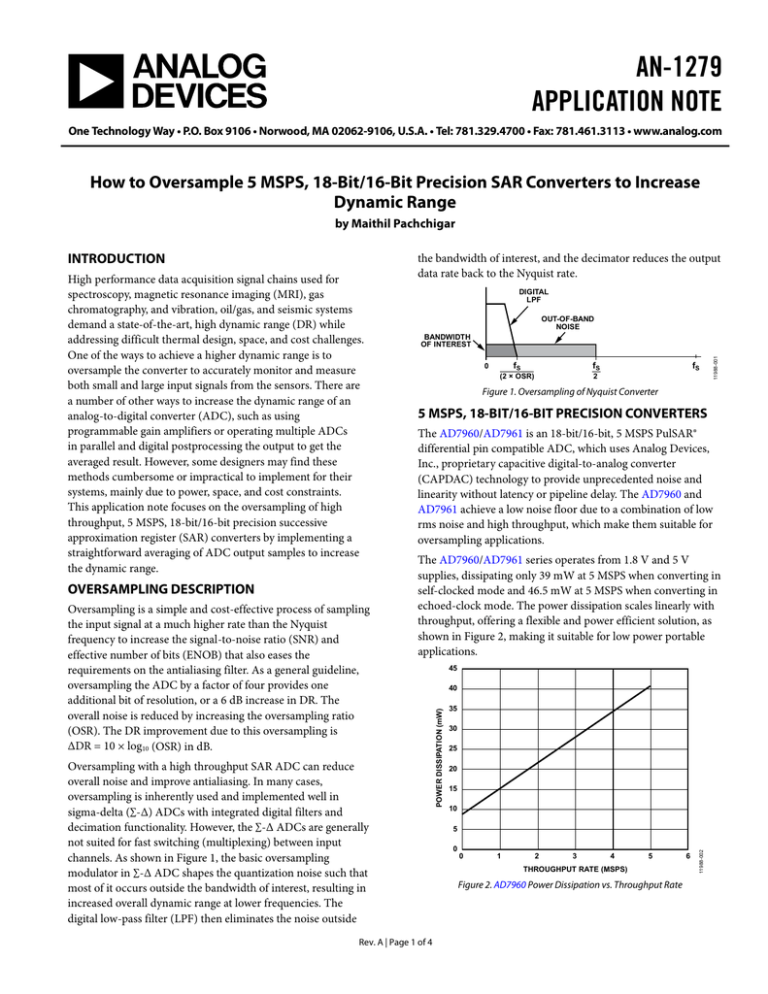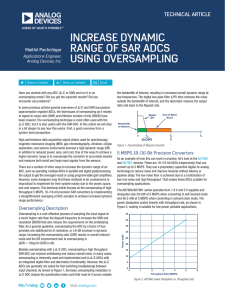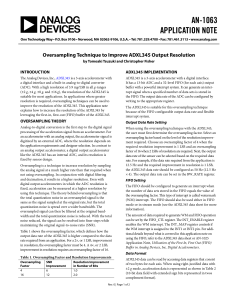AN-1279 APPLICATION NOTE
advertisement

AN-1279 APPLICATION NOTE One Technology Way • P.O. Box 9106 • Norwood, MA 02062-9106, U.S.A. • Tel: 781.329.4700 • Fax: 781.461.3113 • www.analog.com How to Oversample 5 MSPS, 18-Bit/16-Bit Precision SAR Converters to Increase Dynamic Range by Maithil Pachchigar OVERSAMPLING DESCRIPTION Oversampling is a simple and cost-effective process of sampling the input signal at a much higher rate than the Nyquist frequency to increase the signal-to-noise ratio (SNR) and effective number of bits (ENOB) that also eases the requirements on the antialiasing filter. As a general guideline, oversampling the ADC by a factor of four provides one additional bit of resolution, or a 6 dB increase in DR. The overall noise is reduced by increasing the oversampling ratio (OSR). The DR improvement due to this oversampling is ΔDR = 10 × log10 (OSR) in dB. DIGITAL LPF OUT-OF-BAND NOISE fS fS (2 × OSR) 2 0 fS 11988-001 BANDWIDTH OF INTEREST Figure 1. Oversampling of Nyquist Converter 5 MSPS, 18-BIT/16-BIT PRECISION CONVERTERS The AD7960/AD7961 is an 18-bit/16-bit, 5 MSPS PulSAR® differential pin compatible ADC, which uses Analog Devices, Inc., proprietary capacitive digital-to-analog converter (CAPDAC) technology to provide unprecedented noise and linearity without latency or pipeline delay. The AD7960 and AD7961 achieve a low noise floor due to a combination of low rms noise and high throughput, which make them suitable for oversampling applications. The AD7960/AD7961 series operates from 1.8 V and 5 V supplies, dissipating only 39 mW at 5 MSPS when converting in self-clocked mode and 46.5 mW at 5 MSPS when converting in echoed-clock mode. The power dissipation scales linearly with throughput, offering a flexible and power efficient solution, as shown in Figure 2, making it suitable for low power portable applications. Oversampling with a high throughput SAR ADC can reduce overall noise and improve antialiasing. In many cases, oversampling is inherently used and implemented well in sigma-delta (∑-∆) ADCs with integrated digital filters and decimation functionality. However, the ∑-∆ ADCs are generally not suited for fast switching (multiplexing) between input channels. As shown in Figure 1, the basic oversampling modulator in ∑-∆ ADC shapes the quantization noise such that most of it occurs outside the bandwidth of interest, resulting in increased overall dynamic range at lower frequencies. The digital low-pass filter (LPF) then eliminates the noise outside Rev. A | Page 1 of 4 45 40 35 30 25 20 15 10 5 0 0 1 2 3 4 5 THROUGHPUT RATE (MSPS) Figure 2. AD7960 Power Dissipation vs. Throughput Rate 6 11988-002 High performance data acquisition signal chains used for spectroscopy, magnetic resonance imaging (MRI), gas chromatography, and vibration, oil/gas, and seismic systems demand a state-of-the-art, high dynamic range (DR) while addressing difficult thermal design, space, and cost challenges. One of the ways to achieve a higher dynamic range is to oversample the converter to accurately monitor and measure both small and large input signals from the sensors. There are a number of other ways to increase the dynamic range of an analog-to-digital converter (ADC), such as using programmable gain amplifiers or operating multiple ADCs in parallel and digital postprocessing the output to get the averaged result. However, some designers may find these methods cumbersome or impractical to implement for their systems, mainly due to power, space, and cost constraints. This application note focuses on the oversampling of high throughput, 5 MSPS, 18-bit/16-bit precision successive approximation register (SAR) converters by implementing a straightforward averaging of ADC output samples to increase the dynamic range. the bandwidth of interest, and the decimator reduces the output data rate back to the Nyquist rate. POWER DISSIPATION (mW) INTRODUCTION AN-1279 Application Note AD7960/AD7961 EVALUATION SETUP MEASUREMENT RESULTS The simplified schematic of the evaluation set up using the EVAL-AD7960FMCZ and EVAL-SDP-H1 is shown in Figure 3. The oversampling capability is implemented in the AD7960/AD7961 evaluation software by averaging the ADC output samples, that is, summing the number of ADC samples and dividing it by the oversampling ratio to get the increased dynamic range. This software allows the users to select the Oversampling Ratio up to 256 from the drop-down menu located in the Configure tab, as shown in Figure 4. The low frequency 1/f noise of the system, which starts to dominate at lower output data rates less than 20 kSPS, limits the achievable maximum dynamic range. The AD7960/AD7961 series converts the differential voltage of the antiphase analog inputs (IN+ and IN−) into digital output codes. The analog inputs require a common-mode voltage equal to one-half the reference voltage. The low noise and ultralow distortion ADA4899-1 is configured as a unity-gain buffer and drives the inputs of the AD7960/AD7961 with a 0 V to 5 V differential antiphase (180° out of phase with each other). The circuit uses power supplies of +7 V and −2.5 V for the input ADA4899-1 amplifiers to achieve the optimal system performance. The low noise and low power AD8031 amplifier buffers the 5 V reference voltage from the low noise and low drift ADR4550. The AD8031 also buffers the output commonmode voltage (VCM) of the AD7960/AD7961. A spectrum of the signal and the flat noise from dc to fs/2 in Figure 5 and Figure 7 shows that the noise can be filtered to fs/(2 × OSR) to improve the dynamic range and SNR. In this case, the oversampled dynamic range is the ratio of the peak signal power to the noise power measured in the ADC output FFT from dc up to fs/(2 × OSR), where fs is the ADC throughput. ADP7102 +5V ADP7104 +12V ADP2300 +7V –VS = –2.5V ADP124 +5V ADR4550 +7V +12V WALL-WART +5V AD8031 +1.8V +12V 0V TO 5V REFIN REF VDD1 VDD2 VIO CNV± ADA4899-1 AIN+ AIN– IN– 100Ω +7V AD7960/ AD7961 DCO± ADA4899-1 CLK± 5V TO 0V VCM GND –VS VCM 100Ω SIGNAL GENERATOR D± 100Ω IN+ –VS AUDIO PRECISION SYS-2702 100Ω +VS VCM POWER SUPPLY USB PORT SPARTAN-6 FPGA XC6SLX25 PC DSP BF522 LVDS INTERFACE EVAL-SDP-H1 +2.5V +7V EVAL-AD7960FMCZ –VS Figure 3. Simplified Schematic of AD7960/AD7961 Evaluation Setup Rev. A | Page 2 of 4 11988-003 VCM AN-1279 11988-004 Application Note 11988-005 11988-006 Figure 4. AD7960/AD7961 Evaluation Software Panel Figure 6. AD7960 Oversampled FFT Output with fIN = 1 kHz (OSR = 256, REF = 5 V) Figure 5. AD7960 Oversampled FFT Output with No Input Signal (OSR = 256, REF = 5 V) Rev. A | Page 3 of 4 Application Note 11988-008 11988-009 AN-1279 Figure 7. AD7961 Oversampled FFT Output with No Input Signal (OSR = 256, REF = 5 V) Figure 8. AD7961 Oversampled FFT Output with fIN = 1 kHz (OSR = 256, REF = 5 V) 125 19.5 120 DYNAMIC RANGE (dB) 115 110 105 5,000 100 95 90 16 64 256 1,024 4,096 OUTPUT DATA RATE (kHz) 11988-007 The AD7960 and AD7961 data sheets list a typical dynamic range of 100 dB and 96 dB, respectively, using a 5 V reference. Therefore, in theory, oversampling by 256× increases the dynamic range by 24 dB. In reality, the measured oversampled dynamic range of these devices is 123 dB and 120 dB, respectively (see Figure 5 and Figure 7), with no input signal when oversampled by 256× at an output data rate of 19.53 kSPS. The measured oversampled dynamic range shows a 1 dB to 2 dB degradation from the theoretical calculation. The low frequency noise coming from the signal chain components, input source, and printed circuit board (PCB) limits the overall dynamic range performance. With a 1 kHz full-scale sine wave input signal, these devices achieve oversampled SNR of roughly 112 dB and 111 dB, respectively (see Figure 5 and Figure 7). The AD7960 achieves an increased dynamic range as the oversampling ratio increases and the output data rate decreases (see Figure 9). Figure 9. AD7960 Dynamic Range vs. Output Data Rate The combination of exceptional SNR, low power, and outstanding accuracy make the AD7960 and AD7961 ideally suited for applications measuring signals over a wide dynamic range using an oversampling technique. REVISION HISTORY 2/14—Rev. 0 to Rev. A Changes to Figure 3 .......................................................................... 2 Changes to Figure 5 and Figure 6 ................................................... 3 Added Figure 7 and Figure 8; Renumbered Sequentially ........... 4 1/14—Revision 0: Initial Version ©2014 Analog Devices, Inc. All rights reserved. Trademarks and registered trademarks are the property of their respective owners. AN11988-0-2/14(A) Rev. A | Page 4 of 4



